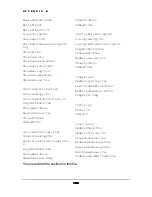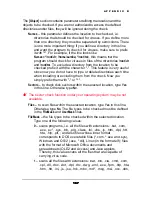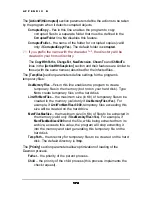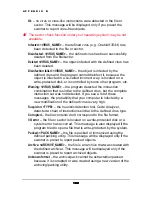
A P P E N D I X B
173
173
173
173
CopyWithPaths
–
Yes
in this line enables the program to copy infected
objects to a separate folder together with their paths.
No
disables
this feature.
ChangeExt
–
Yes
in this line enables the program to change
extensions of infected files.
No
disables this feature.
NewExtension
– the target extension for infected files (valid only if
ChangeExt=Yes
). The default value is
vir
.
If the file doesn’t have
any extension, this extension is added to it.
ChownTo
– the
target name of the file owner
to be assigned to the
infected files that the program failed to disinfect. If you type No
the owner name will not be changed.
ChModTo
– the target
mask for the access attributes
to be assigned to
infected files when they are copied to the infected folder. If you
type
No
the access attributes will not be changed
.
For example,
the value
640
assigns the following attributes to the file:
Read by
owner
,
Write by owner
,
Read by group
.
The
[ActionWithSuspicion]
section parameters define the actions to be taken
by the program when it detects suspicious objects.
SuspiciousCopy
–
Yes
in this line enables the program to copy
suspicious files to a separate folder that must be defined in the
SuspiciousFolder
line.
No
disables this feature.
SuspiciousFolder
– the name of the folder for suspicious copies (valid
only if
SuspiciousCopy=Yes
). The default folder is
suspicious
.
!"
If you prefix the name with the character "
~
", the directory will be
created in your home directory.
!"
If your Kaspersky Anti-Virus for xBSD File Server reports a
suspicious file or sector it’s advisable that you contact our help desk
department. Send these objects to Kaspersky Lab, so that they can
be studied (you may use the address
).
!"
It is advisable that you copy suspicious objects to a separate folder.
This is useful if you deleted the suspicious object and didn't back it
up.
The
CopyWithPaths
,
ChangeExt
,
NewExtension
,
ChownTo
and
ChModTo
lines in the
[ActionWithSuspicion]
section and their features are similar to
those (with the same names) described for the infected files.
















































